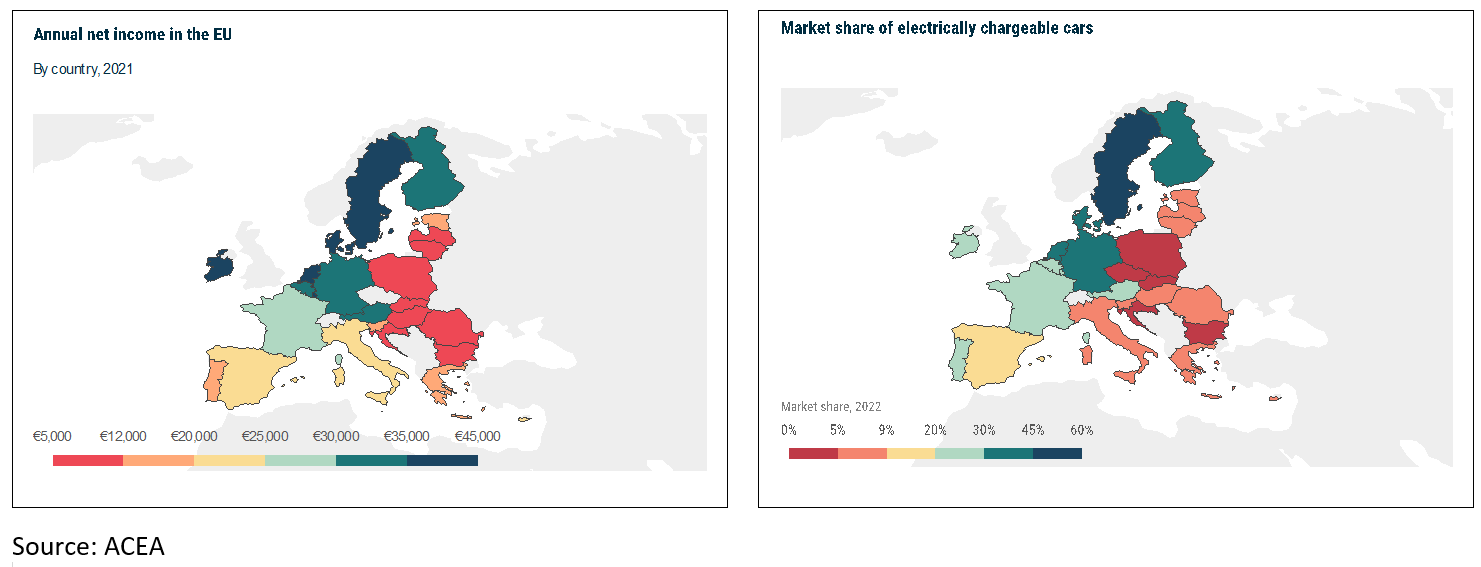

A new ACEA (the European car makers trade association) study compares the penetration of EVs in the car market today with the wealth of EU nations, measured in net income per inhabitant, and the correlation is striking:

There is no doubt electromobility can help, will actually, decarbonize road transport, in the long-term only, though, as the transformation of any car pool of the magnitude we have today in the world will take many years to achieve a complete switchover from thermal propulsion to electric. Providing, of course, that electricity is low-carbon and available in a network of recharging stations as ubiquitous as the existing one distributing fossil liquid fuels, two essential prerequisites to ensure real sustainability of this mode of transportation and the elimination of range anxiety. And assuming electromobility is affordable, social justice being another prerequisite when it comes to transport for all.
In the long-term, on the running cost side, there can be a legitimate doubt about the price of low-carbon electricity, likely more expensive than today, but everyone should now be aware that the energy transition will be painful for our wallets, for everything: food, housing, transport. In the EU, the European Parliament has voted in April the extension to households of the carbon tax for heating and road fuels in 2027, a sure signal to resurrect the Yellow Vests, the middle-class movement against the French carbon tax increase in 2018.
In the short-term, which may last, the question is the upfront cost to replace a thermal vehicle by an EV, a question becoming more acute these days as inflation-burdened Europeans tend to postpone the replacement of their vehicles. They are more durable anyway, so why would you change your car? Surveys of past policies aiming at nudging motorists to change vehicles for cleaner ones, EV included recently, point at the absolute need for purchase subsidies, sometimes called cash-for-clunkers. Just watch for the advocacy of interest groups supporting electromobility. The question is whether the national budgets can afford the subsidies required to favor electromobility, taking us back to the maps above.
Let us compare, in simple math, Sweden and Hungary. They are quite similar countries in population (10 million inhabitants), car pool size (5 and 4.2 million cars, respectively), government spending (50% of GDP), but with one major difference. This is wealth, measured in GDP per inhabitant: $53,000 in Sweden, $12,000 in Hungary. Which means that if every motorist would be given, say a $7,500 subsidy to motivate an EV purchase (the IRA figure), which is not much when the premium can be more than 15,000 € in Europe today in the mid-range segments, and assuming the effort is spread over the next ten years, the burden on the Swedish government would be 1.4% every year of its public spending, but more than 5% in Hungary, half of the spending on education, according to EU statistics, no less.
To govern is to foresee, says the common wisdom, but is also to arbitrate spending, especially in debt-ridden countries (Hungary not faring that bad at 75% of its GDP, compared to the EU average at 85, but Sweden is at 34%). So, besides the mere intensity of the effort to devote to EV subsidizing in public spending, another element to consider would be the absolute public debt level, watched by the financial community, especially in the EU, where German economic orthodoxy and the “Frugal Four” (of which Sweden is a member) easily frown on the “Club Med” style in fashion in the South of Europe, where public debt is usually well above 100 % of GDP. And let us not forget that some political parties, not far from becoming the powers that be, are not convinced by the overarching importance to green the economy.
With these considerations, one should not be surprised that the EV market share momentum toward hegemony is not uniform, eventually. More bluntly, that electromobility will first prevail in the richest countries, which, logically, should also have decarbonized their electricity generation (what of Germany, then?) and invested in a dense public recharging stations network. The strategy of some global carmakers, heavily investing in electromobility for wealthy markets while still improving their thermal catalog, may be the most visible signal that a fully “electro-mobile” world is not for tomorrow, and that the laggards may extend well beyond the list of less advanced economies.
Philippe Marchand is a Bioenergy Steering Committee Member of the European Technology and Innovation Platform (ETIP).